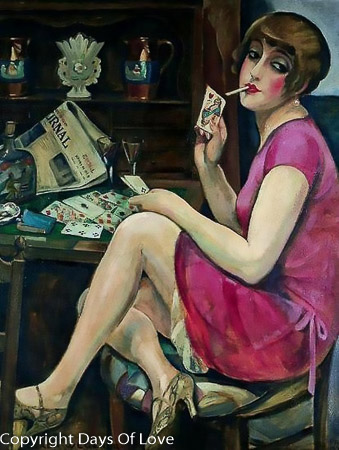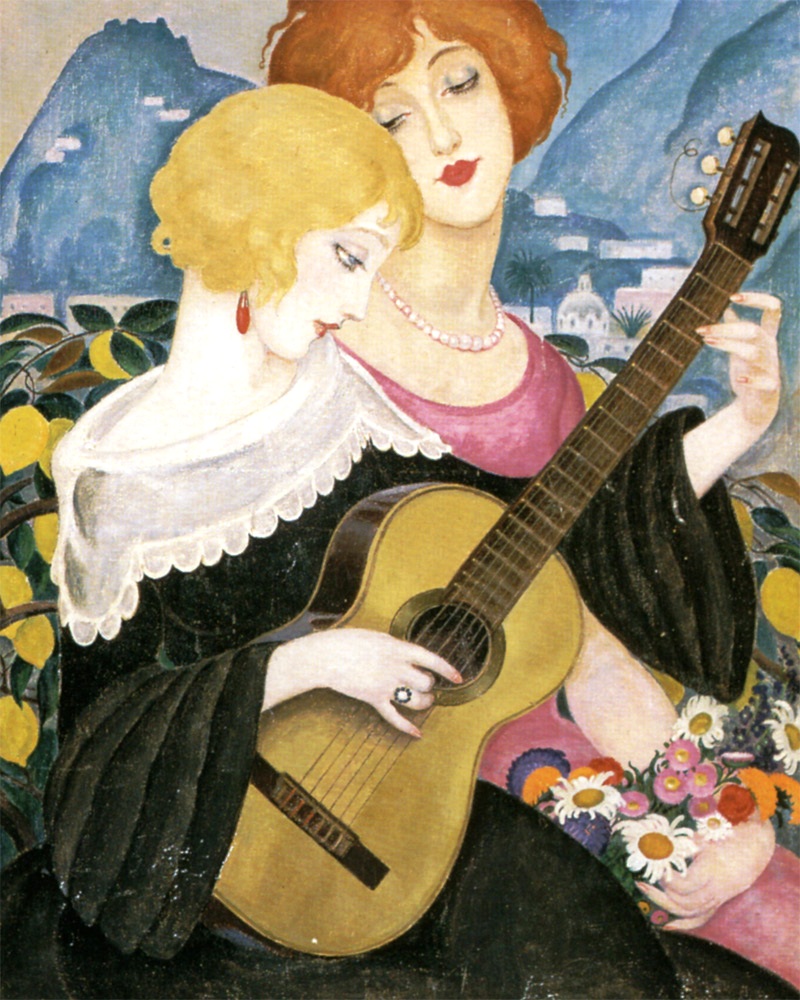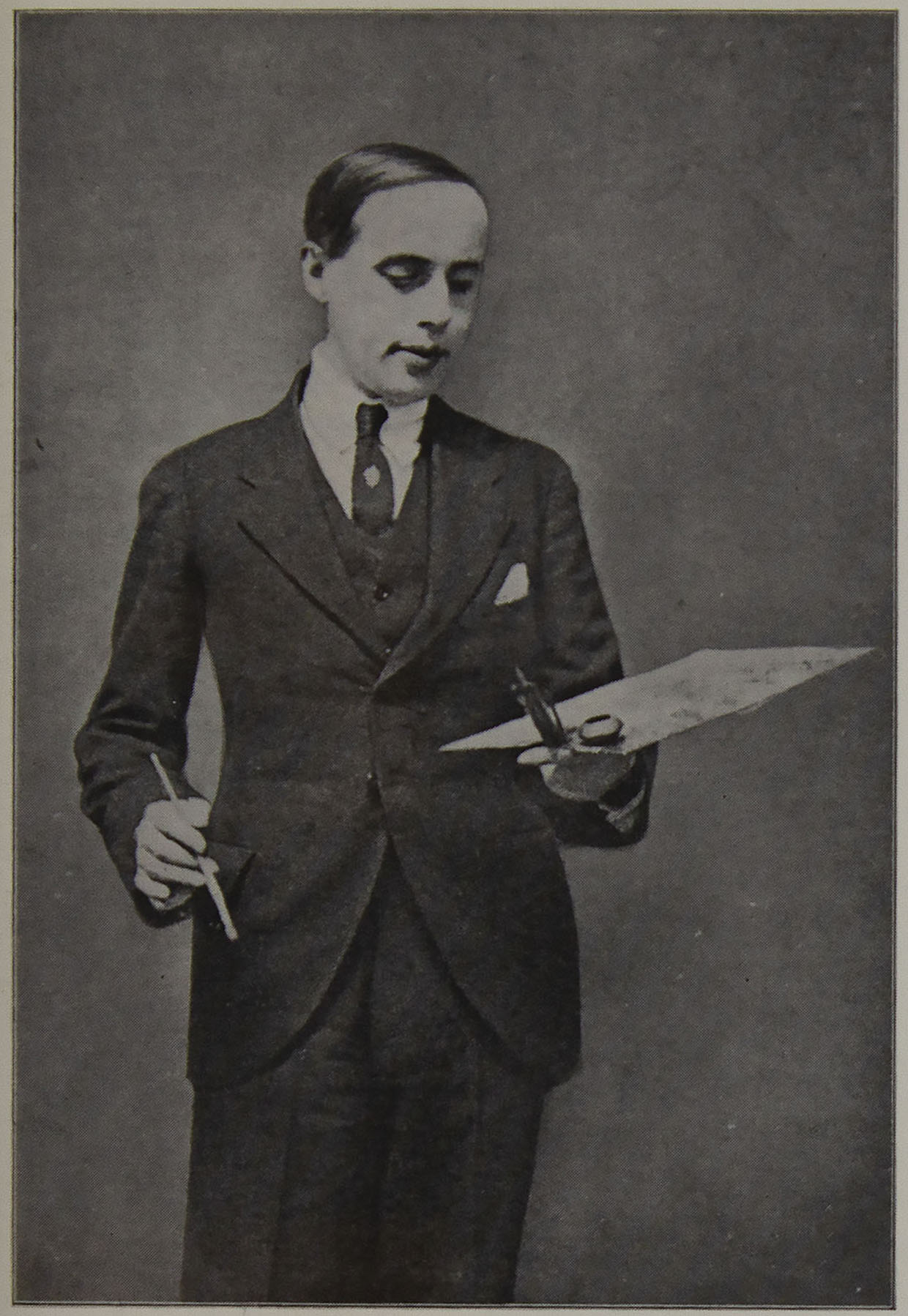Wife Gerda Wegener
Queer Places:
Royal Danish Academy of Fine Arts, Kongens Nytorv 1, 1050 København K, Danimarca
Trinitatis Cemetery, Fiedlerstraße 1, 01307 Dresden, Germania
 Lili
Ilse Elvenes (28 December 1882 – 13 September 1931), better known as Lili
Elbe, was a Danish transgender woman and one of the first identifiable
recipients of sex reassignment surgery.[1][2]
Elbe was born Einar Magnus Andreas Wegener[3]
and was a successful painter under that name. During this time she also
presented as Lili (sometimes spelled Lily) and was publicly
introduced as Einar's sister. After successfully transitioning in 1930, she
changed her legal name to Lili Ilse Elvenes and stopped painting altogether.[4]
The name Lili Elbe was given to her by Copenhagen journalist Louise
Lassen.[5]
She died from complications involving a uterus transplant.[6][7][8]
Her autobiography, Man into Woman, was posthumously published in 1933.[9]
Lili
Ilse Elvenes (28 December 1882 – 13 September 1931), better known as Lili
Elbe, was a Danish transgender woman and one of the first identifiable
recipients of sex reassignment surgery.[1][2]
Elbe was born Einar Magnus Andreas Wegener[3]
and was a successful painter under that name. During this time she also
presented as Lili (sometimes spelled Lily) and was publicly
introduced as Einar's sister. After successfully transitioning in 1930, she
changed her legal name to Lili Ilse Elvenes and stopped painting altogether.[4]
The name Lili Elbe was given to her by Copenhagen journalist Louise
Lassen.[5]
She died from complications involving a uterus transplant.[6][7][8]
Her autobiography, Man into Woman, was posthumously published in 1933.[9]
It is generally believed that Elbe was born in 1882, in Vejle, Denmark. Her
year of birth is sometimes stated as 1886, which appears to be from a book
about her which has some facts changed to protect the identities of the
persons involved. Facts about the life of Elbe's wife
Gerda Gottlieb
suggest that the 1882 date is correct, as they married while at college in
1904, when she would have been just eighteen if the 1886 date were correct.[10][11]
It is likely that Elbe was intersex,[12][13][14][15]
although that has been disputed.[16]
Some reports indicate that she already had rudimentary ovaries in her abdomen
and she may have had Klinefelter syndrome.[6][17]
Elbe met Gerda Gottlieb while they were students at the Royal Danish
Academy of Fine Arts in Copenhagen,[18]
and they married in 1904, when Gottlieb was 19 and Elbe was 22.[10]
They worked as illustrators, with Elbe specializing in landscape paintings,
while Gottlieb illustrated books and fashion magazines. They traveled through
Italy and France, eventually settling in Paris in 1912, where Elbe could live
openly as a woman, and Gottlieb identified as lesbian.[10]
Elbe received the Neuhausens prize in 1907 and exhibited at Kunstnernes
Efterårsudstilling (the Artists' Fall Exhibition), at the Vejle Art Museum,
and in the Saloon and Salon d'Automme in Paris. She is represented at Vejle
Art Museum in Denmark.[19]
Elbe started dressing in women's clothes after filling in for Gottlieb's
absentee model; she was asked to wear stockings and heels so her legs could
substitute for those of the model. Elbe felt surprisingly comfortable in the
clothing and began identifying as a woman.[19]
Over time, Gottlieb became famous for her paintings of beautiful women with
haunting, almond-shaped eyes dressed in chic fashions. In 1913, the
unsuspecting public was shocked to discover that the model who had inspired
Gottlieb's depictions of petites femmes fatales was in fact Elbe.[10]
In the 1920s and 1930s, Elbe regularly presented as a woman, attending
various festivities and entertaining guests in her house. One of the things
she liked to do was disappear into the streets of Paris in the throngs of
revelers during the Carnival, wearing her modeling fashions.[20][21]
Elbe was sometimes introduced by Gottlieb as her own sister when she was
dressed in female attire.[2]
Only her closest friends knew once she had transitioned.


Lili Elbe (?) c.1928
Gerda Wegener (1885–1940) (attributed to)
Wellcome Collection

Einar Wegener,
photo from the book "The confessions of Lili Elbe"
1931
In 1930, Elbe went to Germany for sex reassignment surgery, which was
highly experimental at the time. A series of four operations were carried out
over a period of two years.[21]
The first surgery, removal of the testicles, was made under the supervision of
sexologist Magnus
Hirschfeld in Berlin.[21]
The rest of Elbe's surgeries were carried out by Kurt Warnekros, a doctor at
the Dresden Municipal Women's Clinic.[22]
The second operation was to implant an ovary onto her abdominal musculature,
the third to remove the penis and the scrotum,[23]
and the fourth to transplant a uterus and construct a vaginal canal.[6][24]
At the time of Elbe's last surgery, her case was already a sensation in
newspapers of Denmark and Germany. A Danish court invalidated the couple's
marriage in October 1930,[25]
and Elbe managed to get her sex and name legally changed, including receiving
a passport as Lili Ilse Elvenes. She stopped painting, believing it to
be something that was part of the identity of Einar. After the dissolution of
their marriage, Elbe returned to Dresden for her fourth surgery.
Elbe became the second transgender woman to undergo Gohrbandt's
vaginoplasty technique in 1931, after
Dora Richter underwent
the same procedure.[5]
Her castration and penectomy had been performed by Dr. Ludwig Levy-Lenz
(1889–1966) the previous year. These preliminaries have sometimes caused
confusion over the date of her reassignment surgery.[5]
Gohrbandt's surgery deliberately left remnants of the scrotum intact, with a
view to modifying these into labia at a later date, but for reasons that are
unclear, he did not perform this further procedure himself. Instead, Elvenes'
case was taken over by Dr. Kurt Warnekros (1882–1949), at the Dresden Women's
Clinic. Here, the labiaplasty and a subsequent surgical revision led, in the
pre-antibiotic age, to Elbe's death from infection in September 1931.[5]
The ritual book-burning at the Institute for Sexual Research by Nazi
students in May 1933, the obliteration of the Dresden Women's Clinic and its
records in the Allied bombing raids of February 1945, and the myth-making
process itself have left gaps and inconsistencies in the Lili Elbe narrative
that may never be resolved.[5]
Elbe began a relationship with French art dealer Claude Lejeune, whom she
wanted to marry and with whom she wanted to have children. She was looking
forward to her final surgery involving a uterus transplant.[7][8][24]
In June 1931, Elbe had an operation which consisted of implanting a uterus
and the construction of a vagina, both of which were new and experimental
procedures at that time.[6]
Her immune system rejected the transplanted uterus, however, and she developed
an infection. She died on September 13, 1931, three months after the surgery,
of cardiac arrest brought on by the infection.[6][7][8][24][26]
Elbe was buried on Trinitatisfriedhof in Dresden. The grave was levelled in
the 1960s. In April 2016, a new tombstone was inaugurated, financed by Focus
Features, the production company of The Danish Girl.[27][28]
The LGBT film festival MIX Copenhagen gives four "Lili" awards named after
Elbe.[29]
In 2000, David Ebershoff wrote The Danish Girl, a fictionalized
account of Elbe's life.[30]
It was an international bestseller and was translated into a dozen languages.
In 2015, it was made into a film, also called The Danish Girl, produced
by Gail Mutrux and Neil LaBute and starring Eddie Redmayne as Elbe. The film
was well received at the Venice Film Festival in September 2015,[31]
although it has been criticized for its casting of a cisgender man to play a
transgender woman.[32]
Both the novel and the film omitted topics including Gottlieb's sexuality,
which is evidenced by the subjects in her erotic drawings,[33]
and the disintegration of Gottlieb and Elbe's relationship after their
annulment.[34]
My published books:


BACK TO HOME PAGE

- https://en.wikipedia.org/wiki/Lili_Elbe
 Lili
Ilse Elvenes (28 December 1882 – 13 September 1931), better known as Lili
Elbe, was a Danish transgender woman and one of the first identifiable
recipients of sex reassignment surgery.[1][2]
Elbe was born Einar Magnus Andreas Wegener[3]
and was a successful painter under that name. During this time she also
presented as Lili (sometimes spelled Lily) and was publicly
introduced as Einar's sister. After successfully transitioning in 1930, she
changed her legal name to Lili Ilse Elvenes and stopped painting altogether.[4]
The name Lili Elbe was given to her by Copenhagen journalist Louise
Lassen.[5]
She died from complications involving a uterus transplant.[6][7][8]
Her autobiography, Man into Woman, was posthumously published in 1933.[9]
Lili
Ilse Elvenes (28 December 1882 – 13 September 1931), better known as Lili
Elbe, was a Danish transgender woman and one of the first identifiable
recipients of sex reassignment surgery.[1][2]
Elbe was born Einar Magnus Andreas Wegener[3]
and was a successful painter under that name. During this time she also
presented as Lili (sometimes spelled Lily) and was publicly
introduced as Einar's sister. After successfully transitioning in 1930, she
changed her legal name to Lili Ilse Elvenes and stopped painting altogether.[4]
The name Lili Elbe was given to her by Copenhagen journalist Louise
Lassen.[5]
She died from complications involving a uterus transplant.[6][7][8]
Her autobiography, Man into Woman, was posthumously published in 1933.[9]




